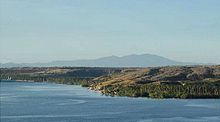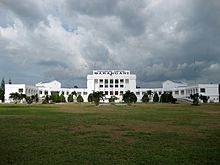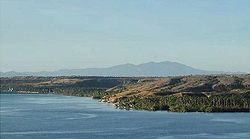Sarangani
Sarangani | |
|---|---|
| Province of Sarangani | |
| Other transcription(s) | |
| •Jawi | سرڠان |
(from top: left to right)Sarangani Provincial Capitol,Tuka Beach inKiamba,Alabel Municipal HallandMaitum coastal. | |
| Anthem: Sarangani, Land of Beauty | |
 Location in the Philippines | |
| Coordinates:5°52′N125°17′E/ 5.87°N 125.28°E | |
| Country | Philippines |
| Region | Soccsksargen |
| Founded | November 28, 1992 |
| Capital | Alabel |
| Largest Municipality | Glan |
| Government | |
| • Type | Sangguniang Panlalawigan |
| •Governor | Rogelio D. Pacquiao (PCM) |
| •Vice Governor | Elmer T. de Peralta (PCM) |
| •Representative | Steve Solon(PCM) |
| • Legislature | Sarangani Provincial Board |
| Area | |
| • Total | 3,601.25 km2(1,390.45 sq mi) |
| • Rank | 37th out of 81 |
| Highest elevation | 2,083 m (6,834 ft) |
| Population (2020 census)[2] | |
| • Total | 558,946 |
| • Rank | 55th out of 81 |
| • Density | 160/km2(400/sq mi) |
| • Rank | 58th out of 81 |
| Divisions | |
| •Independent cities | 0 |
| •Component cities | 0 |
| •Municipalities | |
| •Barangays | 142 |
| •Districts | Legislative district of Sarangani |
| Time zone | UTC+8(PST) |
| ZIP code | 9501–9503, 9514–9517 |
| IDD : area code | +63 (0)83 |
| ISO 3166 code | PH-SAR |
| Spoken languages | |
| Income classification | 2nd class |
| Website | www |
Sarangani,officially theProvince of Sarangani(Cebuano:Lalawigan sa Sarangani;Hiligaynon:Kapuoran sang Sarangani;Maguindanaon:Dairat nu Sarangani,Jawi:دايرت نو سرڠان;Filipino:Lalawigan ng Sarangani), is aprovincein the Philippines located in theSoccsksargenregion.Its capital isAlabel.With a 230-kilometre (140 mi) coastline along theSarangani BayandCelebes Sea,the province is at the southernmost tip ofMindanaoisland, and bordersSouth CotabatoandDavao del Surto the north,Davao Occidentalto the east, and theCelebes Seato the south.
Sarangani is part of the South Cotabato-Cotabato-Sultan Kudarat-Sarangani-General Santos (Soccsksargen) development cluster, and is linked by paved roads to the international airport and harbor ofGeneral Santos.
The province is divided into two sections, separated by theSarangani Bayand the city of General Santos, and it used to be part of South Cotabato until it was made an independent province in 1992.[3]
TheGeneral Santos Metropolitan AreaorMetro General Santosis a metropolitan area encompassing the highly urbanized city ofGeneral Santos,The Regional Agro-Industrial Center of Alabel, the towns of Glan, Kiamba, Maasin, Maitum, Malapatan and Malungon and the neighboring provinces ofSouth Cotabatoadding Metro General Santos addingLake Sebu,Polomolok,T'BoliandTupi.
History
[edit]Early history
[edit]The earliest civilization in the province can be found inMaitum, Sarangani,where theMaitum Anthropomorphic Potteryor Maitum Jars were found. The jars have been dated to approximately 5 BC to 370 AD, one of the oldest in the entire Southeast Asian region and the Philippines. The discovery testified to the long history of cultural exchanges in Sarangani and its people.
The Sarangani was once part ofSultanate of Maguindanao.The establishment of the Sultanate in the area caused more Maguindanaon settlers arrival. After the fall of theSultanate of Maguindanaoas a great power in Mindanao, Datu Uto of Buayan expanded his domain towards Sarangani Bay. Sarangani would eventually be under theSultanate of Buayanuntil the American era.
Spanish colonial era
[edit]Sarangani Island(now part ofDavao Occidental) was namedAntoniaby theSpanishexplorerRuy López de Villalobos[citation needed]in 1543, in honor ofAntonio de Mendoza y Pacheco,theviceroyofNew Spainwho had appointed López de Villalobos to leadan expedition to the Western Islands(now the Philippines) because of theirrelation by marriage.The early inhabitants who first inhabited Sarangani were theindigenousnatives, calledMunaTo,a native term for "first people."[4]

Japanese occupation era
[edit]In 1942, theJapanese troopsoccupied Southern Cotabato.[further explanation needed]In 1945, Filipino troops of the 6th, 10th, 101st and 102nd Infantry Division of thePhilippine Commonwealth Armyand 10th Constabulary Regiment of thePhilippine Constabularyentered in and liberated Southern Cotabato and fought against the Japanese Imperial Army forces during theBattle of Cotabatoat the end ofWorld War IIunder theJapanese Occupation.[citation needed]
Philippine independence
[edit]Before its inception in 1992, Sarangani was part ofSouth Cotabatoas theThird District of South Cotabato.The province was created byRepublic ActNo. 7228on March 16, 1992,[3]penned by Congressman James L. Chiongbian. His wife, Priscilla L. Chiongbian, was the first Governor of Sarangani.[citation needed]
Geography
[edit]Sarangani covers a total area of 3,601.25 square kilometres (1,390.45 sq mi)[5]occupying the southern tip of theSoccsksargenin centralMindanao.The province is bordered on the central-north bySouth Cotabato,northeast byDavao del Sur,east byDavao Occidental,south by theSarangani BayandCelebes Sea,and northwest bySultan Kudarat.

Sarangani is divided into two (eastern and western) sections, separated by theSarangani BayandGeneral Santosin the middle. The western portion comprises the towns ofMaitum,Kiamba,andMaasim,and is bounded on the north bySouth Cotabatoand on the northwest bySultan Kudarat.The eastern section consists ofAlabel,Glan,Malapatan,andMalungon.
Administrative divisions
[edit]Sarangani comprises sevenmunicipalities.Asingle legislative districtencompasses all towns.[5]

| Municipality [i] | Population | ±% p.a. | Area[5] | Density (2020) | Barangay | |||||||
|---|---|---|---|---|---|---|---|---|---|---|---|---|
| (2020)[2] | (2015)[6] | km2 | sq mi | /km2 | /sq mi | |||||||
| 6°06′10″N125°17′31″E/ 6.1027°N 125.2920°E | Alabel | † | 15.8% | 88,294 | 80,359 | +1.81% | 510.98 | 197.29 | 170 | 440 | 13 | |
| 5°49′21″N125°12′17″E/ 5.8225°N 125.2046°E | Glan | 19.6% | 109,547 | 118,263 | −1.45% | 610.30 | 235.64 | 180 | 470 | 31 | ||
| 5°59′19″N124°37′27″E/ 5.9885°N 124.6241°E | Kiamba | 11.8% | 65,774 | 61,058 | +1.43% | 328.68 | 126.90 | 200 | 520 | 19 | ||
| 5°51′40″N124°59′48″E/ 5.8610°N 124.9967°E | Maasim | 11.6% | 64,940 | 59,468 | +1.69% | 500.43 | 193.22 | 130 | 340 | 16 | ||
| 6°03′41″N124°29′45″E/ 6.0613°N 124.4957°E | Maitum | 7.9% | 44,185 | 44,595 | −0.18% | 290.66 | 112.22 | 150 | 390 | 19 | ||
| 5°58′15″N125°17′18″E/ 5.9707°N 125.2882°E | Malapatan | 14.4% | 80,741 | 76,914 | +0.93% | 609.28 | 235.24 | 130 | 340 | 12 | ||
| 6°22′31″N125°16′18″E/ 6.3752°N 125.2717°E | Malungon | 18.9% | 105,465 | 103,604 | +0.34% | 750.92 | 289.93 | 140 | 360 | 31 | ||
| Total | 558,946 | 544,261 | +0.51% | 3,601.25 | 1,390.45 | 160 | 410 | 141 | ||||
| † Provincial capital | Municipality | |||||||||||
| ||||||||||||
Demographics
[edit]| Year | Pop. | ±% p.a. |
|---|---|---|
| 1918 | 19,043 | — |
| 1939 | 24,051 | +1.12% |
| 1948 | 36,166 | +4.64% |
| 1960 | 73,162 | +6.05% |
| 1970 | 127,637 | +5.72% |
| 1975 | 166,179 | +5.43% |
| 1980 | 219,372 | +5.71% |
| 1990 | 283,141 | +2.59% |
| 1995 | 367,006 | +4.98% |
| 2000 | 410,622 | +2.44% |
| 2007 | 475,514 | +2.04% |
| 2010 | 498,904 | +1.76% |
| 2015 | 544,261 | +1.67% |
| 2020 | 558,946 | +0.52% |
| Source: Philippine Statistics Authority[6][7][8] | ||
The population of Sarangani in the 2020 census was 558,946 people,[2]with a density of 160 inhabitants per square kilometre or 410 inhabitants per square mile.
Religion
[edit]Christianityis the majority religion in the province with a total of 79% (48%Roman Catholicism[9]and 31%evangelicals).[10]Other religious minorities areIslam(9%)[11]andIglesia ni Cristo(2%).[12]The remainder is usually divided among other Christian churches.
Economy
[edit]Coconut, corn, rice, banana, mango, durian, rubber, and sugarcane are major crops now being planted by the inhabitants. The province has plantations (mango, banana, pineapple, asparagus), cattle ranches, and commercial fishponds that have been operating in the area, some of which having existed as far back as 40 years.
Electricity comes from theNational Power Corporation,and augmented by a 50 MW power plant in Alabel, the province's capital. Water is provided for by sustainable spring development projects.
Government
[edit]
|
Elected Officials(2022-2025)
Elected Officials(2019-2022)
Elected Officials(2016-2022)
Elected Officials(2013-2016)
Elected Officials(2010-2013)
Elected Officials(2007-2010)
Elected Officials(2004-2007)
Elected Officials(2001-2004)
Elected Officials(1998-2001)
Elected Officials(1995-1998)
Elected Officials(1992-1995)
Note
|
Tourism
[edit]Sarangani celebrates its foundation anniversary every November, named asMunaTo Festival.[21]
Sarangani has ancientburial jars,discovered by archaeologists from theNational MuseuminAyub CaveinMaitum,in 1991 and in 2008, and atSagel Cavein Maitum (now declared byNational Historical Instituteas a national historical site). AmidMindanao's armed conflicts,artifactsfound thereat prove settlements of pre-historic civilization in Maitum.[21][22]
See also
[edit]- Jinkee Pacquiao- wife ofManny Paquiaoand former Sarangani vice governor (2013). Her family is from Sarangani.
References
[edit]- ^"List of Provinces".PSGC Interactive.Makati, Philippines: National Statistical Coordination Board.RetrievedMay 13,2014.
- ^abcCensus of Population (2020)."Region XII (Soccsksargen)".Total Population by Province, City, Municipality and Barangay.Philippine Statistics Authority.RetrievedJuly 8,2021.
- ^ab"An Act Creating the Province of Sarangani"(PDF).House of Representatives of the Philippines.March 16, 1992. Archived fromthe original(PDF)on February 7, 2016.RetrievedJanuary 8,2016.
- ^balita.ph/2008, Man-made island resort now a Sarangani landmark
- ^abc"Province: Sarangani".PSGC Interactive.Quezon City, Philippines:Philippine Statistics Authority.RetrievedJanuary 8,2016.
- ^abCensus of Population (2015)."Region XII (Soccsksargen)".Total Population by Province, City, Municipality and Barangay.Philippine Statistics Authority.RetrievedJune 20,2016.
- ^Census of Population and Housing (2010)."Region XII (Soccsksargen)"(PDF).Total Population by Province, City, Municipality and Barangay.National Statistics Office.RetrievedJune 29,2016.
- ^Censuses of Population (1903–2007)."Region XII (Soccsksargen)".Table 1. Population Enumerated in Various Censuses by Province/Highly Urbanized City: 1903 to 2007.National Statistics Office.
{{cite encyclopedia}}:CS1 maint: numeric names: authors list (link) - ^ab"MAP: Catholicism in the Philippines".January 18, 2015.
- ^ab"Philippine Church National Summary".Archived fromthe originalon October 26, 2019.RetrievedOctober 8,2017.
- ^ab"MAP: Islam in the Philippines".July 17, 2015.
- ^ab"MAP: Iglesia ni Cristo in the Philippines".July 26, 2014.
- ^"Poverty incidence (PI):".Philippine Statistics Authority.RetrievedDecember 28,2020.
- ^"Estimation of Local Poverty in the Philippines"(PDF).Philippine Statistics Authority. November 29, 2005.
- ^"2009 Official Poverty Statistics of the Philippines"(PDF).Philippine Statistics Authority. February 8, 2011.
- ^"Annual Per Capita Poverty Threshold, Poverty Incidence and Magnitude of Poor Population, by Region and Province: 1991, 2006, 2009, 2012 and 2015".Philippine Statistics Authority. August 27, 2016.
- ^"Annual Per Capita Poverty Threshold, Poverty Incidence and Magnitude of Poor Population, by Region and Province: 1991, 2006, 2009, 2012 and 2015".Philippine Statistics Authority. August 27, 2016.
- ^"Annual Per Capita Poverty Threshold, Poverty Incidence and Magnitude of Poor Population, by Region and Province: 1991, 2006, 2009, 2012 and 2015".Philippine Statistics Authority. August 27, 2016.
- ^"Updated Annual Per Capita Poverty Threshold, Poverty Incidence and Magnitude of Poor Population with Measures of Precision, by Region and Province: 2015 and 2018".Philippine Statistics Authority. June 4, 2020.
- ^"2021 Full Year Official Poverty Statistics of the Philippines"(PDF).Philippine Statistics Authority. August 15, 2022.RetrievedApril 28,2024.
- ^ab"'MunaTo' festival ".Manila Bulletin.November 29, 2013.RetrievedApril 17,2016.
The provincial government started their celebration of its 21st foundation anniversary on Thursday and officially opened its 11th "MunaTo Festival" starting November 27 and will run up to December 6, this year.
- ^Pelima, Russtum G. (November 10, 2008)."Island resort now Sarangani landmark".Philippine Information Agency.PIO Sarangani/ICC GenSan. Archived fromthe originalon February 11, 2009.RetrievedApril 17,2016.
Despite armed conflicts occurring in Mindanao, artifacts found by archaeologists from the National Museum in Ayub Cave in 1991 and Sagel Cave this year prove settlements of pre-historic civilization in Maitum.
External links
[edit] Media related toSaranganiat Wikimedia Commons
Media related toSaranganiat Wikimedia Commons Geographic data related toSaranganiatOpenStreetMap
Geographic data related toSaranganiatOpenStreetMap- Official Website of the Provincial Government of Sarangani
- Local Governance Performance Management System








